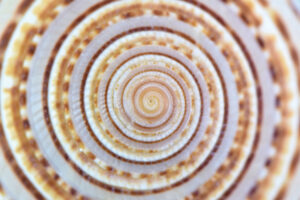Chemistry in Pictures
Throughout spring semester 2021, students in chemistry professor Tom Richmond’s Integrated Chemistry for Health Sciences course have been taking pictures of chemistry in the world around them. From using shaving cream as sunburn relief to the thermodynamics of digestion, the students have put into pictures the principles they’ve learned in class. Now one of those pictures, documenting a home chemistry experiment by pre-nursing student Ashlee Taft Nelson, is published in the magazine Chemical and Engineering News.
“The Chemistry in Pictures project helped me see that chemistry, as a whole, is so much broader than just a list of elements,” Nelson says. “It is found in every part of life that helps defines processes of growth and change.”
The photo shows two eggs that have been soaked in different solutions to illustrate how fluid moves through a membrane. An egg sans shell soaked in water will swell, since the concentration of water inside the egg is less than outside and the water moves through the membrane to balance things out. An egg soaked in corn syrup will shrink, though, since there’s more water inside the egg than in the corn syrup.
Developed during the COVID-19 pandemic, the Chemistry in Pictures assignment helps students drawing insightful connections between the concepts they learned in class and their everyday lives and fulfill the learning objectives of a chemistry education. Publication of Nelson’s photo is, Richmond hopes, the first of many opportunities to share his students’ insights with the world.
See other examples of: blood testing, protein denaturation and other student projects.
Developing the assignment
For years, Richmond has been asking his introductory chemistry students to create and solve chemistry problems that mattered to them, in part to hone their science communication skills.
“Altering this basic format by adding a picture that they have taken with their cellphone has proven to be an effective way for students to personalize their learning and works well for a generation of students who live on social media,” he says. “It also prompts them to more directly see the relevance of chemistry in their lives whether in the kitchen, at work or at play.”
During the COVID-19 pandemic, Chemistry in Pictures proved useful in checking in on students’ learning while access to the laboratories was limited. Richmond and veteran TA Lizabeth Cowgill realized that the assignment could do even more.
“We realized this assignment could serve as a new curriculum tool that would not only serve as an artifact regarding student understanding but could also contribute to changing a student’s attitude toward the subject of chemistry,” says Cowgill, now a graduate student in the College of Pharmacy.
Mark St. André, Associate Dean in the U’s Office of Learning Outcomes Assessment says he works with a lot of departments to tailor assignments to meet university learning objectives. Chemistry in Pictures, he says, is unique.
“It makes sense what he’s trying to do,” St. André says. “He’s trying to get them to think with a different side of their brain by representing the problem using pictures. I’m not anywhere close to a brain expert, but common sense would tell us that activating the creativity you need to build a picture is likely to help you think about the issue differently and probably increase your understanding of it.”
Bringing chemistry into focus
The Integrated Chemistry for Health Sciences course is for pre-nursing students and others heading into healthcare fields. Understanding the chemistry behind why a patient is ill is vital, says Mardie Clayton, professor of nursing.
“Basic principles of chemistry transcend human physiology and pathophysiology, enabling students to understand how the body works normally and abnormally,” she says, with the photo of fluid moving in and out of the eggs as a good example. “Understanding the movement of fluids is vital to understanding cellular function and to the management of associated diseases such as heart disease.”
Richmond says that the Chemistry in Pictures experience also teaches students to observe and interpret chemical phenomena. “The ability to communicate scientific concepts – whether to patients or peers – is certainly needed to address many critical issues in our society at large,” he says.
Watching the flashbulb light up
Cowgill gathered feedback on Chemistry in Pictures as the class progressed. The students thoroughly enjoyed the creative freedom of the assignment, she says.
One student said: “If I could change one thing about these assignments it would be to have them more frequently. Chemistry in Pictures assignments helped me apply chemistry to everyday things in my life. It forced me to have to think in a different way and ask how and why questions. It was one of the most beneficial assignments for me personally because it felt interactive even despite being online.”
Students completed five Chemistry in Pictures assignments over the course of the semester, totaling nearly 700 among the entire class. Cowgill says that while the first two assignments showed solid understanding of content, the creativity and real-life application began to shine through starting at the third assignment.
“It was like a lightbulb had gone on in all 135 students!” she says. “I started to see experimental design and treatment, adventure and risk taking, research incorporation, friends and family involvement and engagement, but most importantly, spark.” The students, she says, were starting to go above and beyond the expectations of the assignment. And the spark was never lost.
“I saw their minds challenging their own comprehension and understanding and read the excitement when, say, their proposed experiment went as planned,” she says. “These students blew me away—absolute brilliance.”
Lasting memories of a first exposure
In response to an open call by Chemical and Engineering News for chemistry-related photos, Richmond sent in Nelson’s “egg-sample” image. It was published in the May 13 edition of the magazine, which is read by more than 150,000 chemistry professionals.
“Before taking Integrated Chemistry for Health Sciences, I saw chemistry as a math-based science using the list of elements found on the periodic table as variables,” Nelson says. “This project taught me to see that applications of chemistry are everywhere and to be a better observer of my environment.”
“I have been impressed with creativity and level of detail that many students exhibited in this project and suspect that their creations will be one of the lasting memories of their first exposure to chemistry,” Richmond says. “Perhaps it is not surprising that this ‘cell phone’ generation of students became adept at photographically documenting chemistry in their lives. We now often see pictures in lab reports in more advanced courses and even graduate research presentations in the department.”
Cowgill says that the assignment allows students to act as their own instructors. “It not only provides them complete creative freedom but keeps their learning unrestricted, boundless, free,” she says. “This assignment protects the most sacred component of learning: self. It is through assignments like Chemistry in Pictures where you can see raw and unedited active learning, application and educational growth tangibly.”
By Paul Gabrielsen, first published in @theU






